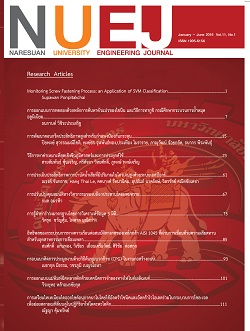ผลของการแผ่รังสีอัลตร้าโซนิคและอัลตร้าไวโอเลตต่อความว่องไวในการเร่งปฏิกิริยา โฟโตคะตะไลติกของไทเทเนียมไดออกไซด์
Main Article Content
Abstract
ผลของการแผ่รังสีอัลตร้าโซนิคและอัลตร้าไวโอเลตต่อความว่องไวในการเร่งปฏิกิริยา
โฟโตคะตะไลติกของไทเทเนียมไดออกไซด์
บทคัดย่อ – ไทเทเนียมไดออกไซด์ซึ่งเป็นตัวเร่งปฏิกิริยาด้วยแสงถูกสังเคราะห์ขึ้นโดยการใช้อัลตร้าโซนิคและอัลตร้าไวโอเลตร่วมในกระบวนการโซล-เจล ไทเทเนียมไดออกไซด์ที่เตรียมได้จะถูกนำมาวิเคราะห์คุณลักษณะเฉพาะด้วยเครื่องXRD, BET และ ESR เมทิลีนบลูเป็นสารมลพิษอินทรีย์ที่ถูกนำมาใช้ในการทดสอบการย่อยสลายด้วยตัวเร่งปฏิกิริยาไทเทเนียมไดออกไซด์ในปฏิกิริยาโฟโตคะตะไลติก ไทเทเนียมไดออกไซด์ที่เตรียมขึ้นโดยใช้อัลตร้าโซนิคร่วมในกระบวนการโซล-เจล มีความว่องไวในปฏิกิริยาโฟโตคะตะไลติกมากกว่าตัวเร่งปฏิกิริยาที่เตรียมขึ้นโดยใช้การกวนด้วยแท่งแม่เหล็ก เนื่องจากมีปริมาณของ Oxygen vacancyมากกว่า และถึงแม้ว่าตัวเร่งปฏิกิริยาที่เตรียมขึ้นโดยใช้อัล ตร้าโซนิคควบคู่กับอัลตร้าไวโอเลตในกระบวนการโซล-เจล จะมีปริมาณ Oxygen vacancy สูงที่สุด แต่ความว่องไวในการเร่งปฏิกิริยาโฟโตคะตะไลติกของตัวเร่งปฏิกิริยาดังกล่าวก็ไม่ได้สูงที่สุด การเตรียมตัวเร่งปฏิกิริยาโดยใช้อัลตร้า โซนิคควบคู่กับอัลตร้าไวโอเลตในกระบวนการโซล-เจล คาดว่าจะทำให้เกิด Oxygen vacancy ขึ้นในผลึก ซึ่ง Oxygen vacancy เหล่านี้จะทำหน้าที่เป็นศูนย์กลางที่ทำให้เกิดการรวมตัวกันของอิเล็คตรอนและโฮล และส่งผลให้ประสิทธิภาพในการเร่งปฏิกิริยาโฟโตคะตะไลติกลดลง
Effects of Ultrasonic and Ultraviolet Irradiation on Photocatalytic Activity of TiO2
Abstract – The TiO2 photocatalysts were synthesized by using ultrasonic and ultraviolet assisted sol-gel methods. The obtained TiO2 nanopaticles were characterized by X-ray diffraction (XRD), Brunauer-Emmett-Teller (BET) and Electron spin resonance spectroscopy (ESR). Methylene blue was used as the organic pollutant to observe the photocatalytic degradation ability of the TiO2 catalysts. The TiO2 prepared by ultrasonic assisted sol-gel method showed higher photocatalytic activity than that prepared by magnetic stirring due to more oxygen vacancy sites. Although TiO2 catalysts prepared by ultrasonic coupled with ultraviolet assisted sol-gel possessed the highest oxygen vacancy, its photocatalytic activity was not the highest. The preparation by ultrasonic coupled with ultraviolet assisted sol-gel methods was ascribed to the formation of bulk oxygen vacancy which act as recombination center and decreased the photocatalytic performance of TiO2.
Article Details
References
B. Gao, Y. Ma, Y. Cao, J. Zhao and J. Yao, Effect of ultraviolet irradiation on crystallization behavior and surface microstructure of titania in the sol–gel process, J. Solid State Chem. 179 (2006): 41-48.
B. Neppolian, Q. Wang, H. Jung and H. Choi, Ultrasonic-assisted sol-gel method of preparation of TiO2 nano-particles: characterization, properties and 4-chlorophenol removal application, Ultrason. Sonochem. 15 (2008): 649-658.
S. Koda, K. Tanaka, H. Sakamoto, T. Matsuoka and H. Nomura, Sonochemical efficiency during single-bubble cavitation in water, J. Phys. Chem. A 108 (2004): 11609-11612.
K.S. Suslick and G.J. Price, Applications of ultrasound to materials chemistry, Annu. Rev. Mater. Sci. 29 (1999): 295-326.
I. Nakamura, N. Negishi, S. Kutsuna, T. Ihara, S. Sugihara and K. Takeuchi, Role of oxygen vacancy in the plasma-treated TiO2 photocatalyst with visible light activity for NO removal, J. Mol. Catal. A: Chem. 161 (2000): 205-212.
H.M. Liu, W.S. Yang, Y. Ma, Y.A. Cao and J.N. Yao, Promoted phase transition of titania nanoparticles prepared by a photo-assisted sol-gel method, New J. Chem. 26 (2002): 975-977.
H.M. Liu, W.S. Yang, Y. Ma, Y.A. Cao, J.N. Yao, J. Zhang and T.D. Hu, Synthesis and characterization of titania prepared by using a photoassisted sol−gel method, Langmuir 19 (2003): 3001-3005.
Y. Huo, J. Zhu, J. Li, G. Li and H. Li, An active La/TiO2 photocatalyst prepared by ultrasonication-assisted sol–gel method followed by treatment under supercritical conditions, J. Mol. Catal. A: Chem 278 (2007): 237-243.
R. Schaub, P. Thostrup, N. Lopez, E. Laegsgaard, I. Stengsgaard, J. K. Norskov and F. Besenbacher, Oxygen vacancies as active sites for water dissociation on rutile TiO2(110), Phys. Rev. Lett. 87 (2001): 266104/1-266104/4.
G. Yanga, T. Wanga, B. Yanga, Z. Yanc, S. Dingb and T. Xiaod, Enhanced visible-light activity of F-N co-doped TiO2 nanocrystals via nonmetal impurity, Ti3+ ions and oxygen vacancies, Appl. Surf. Sci. 287 (2013): 135-142.
F. Liu, L. Lu, P. Xiao, H. He, L. Qiao and Y. Zhang, Effect of oxygen vacancies on photocatalytic efficiency of TiO2 nanotubes aggregation, Bull. Korean Chem. Soc. 33 (2012): 2255–2259.
M. Kong, Y. Li, X. Chen, T. Tian, P. Fang, F. Zheng and X. Zhao, Tuning the relative concentration ratio of bulk defects to surface defects in TiO2 nanocrystals leads to high photocatalytic efficiency, J. Am. Chem. Soc. 133 (2011): 16414-16417.


